Ronkonkoma Branch
The Ronkonkoma Branch is a rail service operated by the Long Island Rail Road (LIRR) in the U.S. state of New York. On LIRR maps and printed schedules, the "Ronkonkoma Branch" includes trains running along the railroad's Main Line from Hicksville (where the Port Jefferson Branch leaves the Main Line) to Ronkonkoma, and between Ronkonkoma and the Main Line's eastern's terminus at Greenport.[1][2] The section of the Main Line east of Ronkonkoma is not electrified and is referred to as the Greenport Branch.
| Ronkonkoma Branch | ||||||||||||||||||||||||||||||||||||||||||||||||||||||||||||||||||||||||||||||||||||||||||||||||||||||||||||||||||||||||||||||||||||||||||||||||||||||||||||||||||||||||||||||||||||||||||||||||||||||||||||||||||||||||||||||||||||||||||||||||||||||||||||||||||||||||||||||||||||||||||||||||||||||||||||||||||||||||||||||||||||||||||||||||||||||||||||
|---|---|---|---|---|---|---|---|---|---|---|---|---|---|---|---|---|---|---|---|---|---|---|---|---|---|---|---|---|---|---|---|---|---|---|---|---|---|---|---|---|---|---|---|---|---|---|---|---|---|---|---|---|---|---|---|---|---|---|---|---|---|---|---|---|---|---|---|---|---|---|---|---|---|---|---|---|---|---|---|---|---|---|---|---|---|---|---|---|---|---|---|---|---|---|---|---|---|---|---|---|---|---|---|---|---|---|---|---|---|---|---|---|---|---|---|---|---|---|---|---|---|---|---|---|---|---|---|---|---|---|---|---|---|---|---|---|---|---|---|---|---|---|---|---|---|---|---|---|---|---|---|---|---|---|---|---|---|---|---|---|---|---|---|---|---|---|---|---|---|---|---|---|---|---|---|---|---|---|---|---|---|---|---|---|---|---|---|---|---|---|---|---|---|---|---|---|---|---|---|---|---|---|---|---|---|---|---|---|---|---|---|---|---|---|---|---|---|---|---|---|---|---|---|---|---|---|---|---|---|---|---|---|---|---|---|---|---|---|---|---|---|---|---|---|---|---|---|---|---|---|---|---|---|---|---|---|---|---|---|---|---|---|---|---|---|---|---|---|---|---|---|---|---|---|---|---|---|---|---|---|---|---|---|---|---|---|---|---|---|---|---|---|---|---|---|---|---|---|---|---|---|---|---|---|---|---|---|---|---|---|---|---|---|---|---|---|---|---|---|---|---|---|---|---|---|---|---|---|---|---|---|---|---|---|---|---|---|---|---|---|---|---|---|---|---|---|---|---|
 | ||||||||||||||||||||||||||||||||||||||||||||||||||||||||||||||||||||||||||||||||||||||||||||||||||||||||||||||||||||||||||||||||||||||||||||||||||||||||||||||||||||||||||||||||||||||||||||||||||||||||||||||||||||||||||||||||||||||||||||||||||||||||||||||||||||||||||||||||||||||||||||||||||||||||||||||||||||||||||||||||||||||||||||||||||||||||||||
| Overview | ||||||||||||||||||||||||||||||||||||||||||||||||||||||||||||||||||||||||||||||||||||||||||||||||||||||||||||||||||||||||||||||||||||||||||||||||||||||||||||||||||||||||||||||||||||||||||||||||||||||||||||||||||||||||||||||||||||||||||||||||||||||||||||||||||||||||||||||||||||||||||||||||||||||||||||||||||||||||||||||||||||||||||||||||||||||||||||
| Status | Operational | |||||||||||||||||||||||||||||||||||||||||||||||||||||||||||||||||||||||||||||||||||||||||||||||||||||||||||||||||||||||||||||||||||||||||||||||||||||||||||||||||||||||||||||||||||||||||||||||||||||||||||||||||||||||||||||||||||||||||||||||||||||||||||||||||||||||||||||||||||||||||||||||||||||||||||||||||||||||||||||||||||||||||||||||||||||||||||
| Owner | Long Island Rail Road | |||||||||||||||||||||||||||||||||||||||||||||||||||||||||||||||||||||||||||||||||||||||||||||||||||||||||||||||||||||||||||||||||||||||||||||||||||||||||||||||||||||||||||||||||||||||||||||||||||||||||||||||||||||||||||||||||||||||||||||||||||||||||||||||||||||||||||||||||||||||||||||||||||||||||||||||||||||||||||||||||||||||||||||||||||||||||||
| Locale | Nassau and Suffolk County, New York, USA | |||||||||||||||||||||||||||||||||||||||||||||||||||||||||||||||||||||||||||||||||||||||||||||||||||||||||||||||||||||||||||||||||||||||||||||||||||||||||||||||||||||||||||||||||||||||||||||||||||||||||||||||||||||||||||||||||||||||||||||||||||||||||||||||||||||||||||||||||||||||||||||||||||||||||||||||||||||||||||||||||||||||||||||||||||||||||||
| Termini | Hicksville Ronkonkoma Greenport | |||||||||||||||||||||||||||||||||||||||||||||||||||||||||||||||||||||||||||||||||||||||||||||||||||||||||||||||||||||||||||||||||||||||||||||||||||||||||||||||||||||||||||||||||||||||||||||||||||||||||||||||||||||||||||||||||||||||||||||||||||||||||||||||||||||||||||||||||||||||||||||||||||||||||||||||||||||||||||||||||||||||||||||||||||||||||||
| Stations | 14 | |||||||||||||||||||||||||||||||||||||||||||||||||||||||||||||||||||||||||||||||||||||||||||||||||||||||||||||||||||||||||||||||||||||||||||||||||||||||||||||||||||||||||||||||||||||||||||||||||||||||||||||||||||||||||||||||||||||||||||||||||||||||||||||||||||||||||||||||||||||||||||||||||||||||||||||||||||||||||||||||||||||||||||||||||||||||||||
| Service | ||||||||||||||||||||||||||||||||||||||||||||||||||||||||||||||||||||||||||||||||||||||||||||||||||||||||||||||||||||||||||||||||||||||||||||||||||||||||||||||||||||||||||||||||||||||||||||||||||||||||||||||||||||||||||||||||||||||||||||||||||||||||||||||||||||||||||||||||||||||||||||||||||||||||||||||||||||||||||||||||||||||||||||||||||||||||||||
| Type | Commuter rail | |||||||||||||||||||||||||||||||||||||||||||||||||||||||||||||||||||||||||||||||||||||||||||||||||||||||||||||||||||||||||||||||||||||||||||||||||||||||||||||||||||||||||||||||||||||||||||||||||||||||||||||||||||||||||||||||||||||||||||||||||||||||||||||||||||||||||||||||||||||||||||||||||||||||||||||||||||||||||||||||||||||||||||||||||||||||||||
| System | Long Island Rail Road | |||||||||||||||||||||||||||||||||||||||||||||||||||||||||||||||||||||||||||||||||||||||||||||||||||||||||||||||||||||||||||||||||||||||||||||||||||||||||||||||||||||||||||||||||||||||||||||||||||||||||||||||||||||||||||||||||||||||||||||||||||||||||||||||||||||||||||||||||||||||||||||||||||||||||||||||||||||||||||||||||||||||||||||||||||||||||||
| Services | Ronkonkoma Branch Greenport Branch | |||||||||||||||||||||||||||||||||||||||||||||||||||||||||||||||||||||||||||||||||||||||||||||||||||||||||||||||||||||||||||||||||||||||||||||||||||||||||||||||||||||||||||||||||||||||||||||||||||||||||||||||||||||||||||||||||||||||||||||||||||||||||||||||||||||||||||||||||||||||||||||||||||||||||||||||||||||||||||||||||||||||||||||||||||||||||||
| Operator(s) | Metropolitan Transportation Authority | |||||||||||||||||||||||||||||||||||||||||||||||||||||||||||||||||||||||||||||||||||||||||||||||||||||||||||||||||||||||||||||||||||||||||||||||||||||||||||||||||||||||||||||||||||||||||||||||||||||||||||||||||||||||||||||||||||||||||||||||||||||||||||||||||||||||||||||||||||||||||||||||||||||||||||||||||||||||||||||||||||||||||||||||||||||||||||
| Rolling stock | Budd M3, Bombardier M7 (West of Ronkonkoma) Kawasaki C3, DE30AC (East of Ronkonkoma) | |||||||||||||||||||||||||||||||||||||||||||||||||||||||||||||||||||||||||||||||||||||||||||||||||||||||||||||||||||||||||||||||||||||||||||||||||||||||||||||||||||||||||||||||||||||||||||||||||||||||||||||||||||||||||||||||||||||||||||||||||||||||||||||||||||||||||||||||||||||||||||||||||||||||||||||||||||||||||||||||||||||||||||||||||||||||||||
| History | ||||||||||||||||||||||||||||||||||||||||||||||||||||||||||||||||||||||||||||||||||||||||||||||||||||||||||||||||||||||||||||||||||||||||||||||||||||||||||||||||||||||||||||||||||||||||||||||||||||||||||||||||||||||||||||||||||||||||||||||||||||||||||||||||||||||||||||||||||||||||||||||||||||||||||||||||||||||||||||||||||||||||||||||||||||||||||||
| Opened | 1837-1844 | |||||||||||||||||||||||||||||||||||||||||||||||||||||||||||||||||||||||||||||||||||||||||||||||||||||||||||||||||||||||||||||||||||||||||||||||||||||||||||||||||||||||||||||||||||||||||||||||||||||||||||||||||||||||||||||||||||||||||||||||||||||||||||||||||||||||||||||||||||||||||||||||||||||||||||||||||||||||||||||||||||||||||||||||||||||||||||
| Technical | ||||||||||||||||||||||||||||||||||||||||||||||||||||||||||||||||||||||||||||||||||||||||||||||||||||||||||||||||||||||||||||||||||||||||||||||||||||||||||||||||||||||||||||||||||||||||||||||||||||||||||||||||||||||||||||||||||||||||||||||||||||||||||||||||||||||||||||||||||||||||||||||||||||||||||||||||||||||||||||||||||||||||||||||||||||||||||||
| Track gauge | 4 ft 8 1⁄2 in (1,435 mm) standard gauge | |||||||||||||||||||||||||||||||||||||||||||||||||||||||||||||||||||||||||||||||||||||||||||||||||||||||||||||||||||||||||||||||||||||||||||||||||||||||||||||||||||||||||||||||||||||||||||||||||||||||||||||||||||||||||||||||||||||||||||||||||||||||||||||||||||||||||||||||||||||||||||||||||||||||||||||||||||||||||||||||||||||||||||||||||||||||||||
| Electrification | 750 V (DC) Third rail (west of Ronkonkoma) | |||||||||||||||||||||||||||||||||||||||||||||||||||||||||||||||||||||||||||||||||||||||||||||||||||||||||||||||||||||||||||||||||||||||||||||||||||||||||||||||||||||||||||||||||||||||||||||||||||||||||||||||||||||||||||||||||||||||||||||||||||||||||||||||||||||||||||||||||||||||||||||||||||||||||||||||||||||||||||||||||||||||||||||||||||||||||||
| ||||||||||||||||||||||||||||||||||||||||||||||||||||||||||||||||||||||||||||||||||||||||||||||||||||||||||||||||||||||||||||||||||||||||||||||||||||||||||||||||||||||||||||||||||||||||||||||||||||||||||||||||||||||||||||||||||||||||||||||||||||||||||||||||||||||||||||||||||||||||||||||||||||||||||||||||||||||||||||||||||||||||||||||||||||||||||||
The western segment between Hicksville and Ronkonkoma sees 24-hour service to Penn Station in New York City. The eastern segment between Ronkonkoma and Greenport is served by diesel-electric trains, and only sees a handful of trips each day. The eastern segment is also the only dark territory area of the Long Island Rail Road, meaning that it does not have signals.[3]
Segments
Hicksville to Ronkonkoma

The western segment of the line from Hicksville to Ronkonkoma was electrified in 1987,[4] creating a one-seat ride to Penn Station. Formerly, service on this segment was provided by diesel trains, which could not enter Penn Station, requiring a transfer. Average rush-hour trip time from Ronkonkoma to Penn Station decreased from 97 minutes pre-electrification (including the mandatory transfer from a diesel to an electric train) to 71 minutes afterwards.[5]
The $168.5 million project attracted many new passengers. A survey of peak-hour Ronkonkoma Branch passengers conducted by the LIRR in April 1988 found that 42 percent of the branch's passengers were new to the line: 34 percent switched from other lines (the Port Jefferson and Montauk Branches), 6 percent were new to the LIRR as a whole and 2 percent recently returned to the LIRR. By September 1988, over 2,000 new riders during the morning rush hour had switched to the Ronkonkoma Branch, much of which occurred in the first month after electrification, faster than the LIRR expected. Commuters complained that the expanded parking facilities at Ronkonkoma built in anticipation of electrification were overcrowded and already inadequate, and that double-parking and vandalism were rampant.[5]
In the decades since, the amount of parking at Ronkonkoma has expanded. In 2012, the Metropolitan Transportation Authority (MTA) started adding a second track to the line between Farmingdale and Ronkonkoma to increase capacity. The project was ultimately completed in 2018.[6][7]
Greenport Branch
The 46 miles (74 km) between Ronkonkoma and Greenport, known as the Greenport Branch, is the only remaining dark territory area on the Long Island Rail Road that does not have signals.[3] The relatively small amount of train movements on this segment are governed by train orders and timetable authority. This segment is served by diesel-electric "scoots", most of which terminate at Ronkonkoma, requiring customers traveling west of Ronkonkoma to transfer there. Three eastbound and four westbound scoots travel each weekday between Ronkonkoma and Greenport. Also, one eastbound train each weekday runs as far as Yaphank. Weekend service consists of four round-trips each day between Ronkonkoma and Greenport. On Fridays during the summer, the eastbound trip to Yaphank is extended to Greenport, and one additional evening trip runs from Greenport to Jamaica, running express between Ronkonkoma and Jamaica. Added in summer 2016, this is the only Greenport scoot trip to serve the New York City terminals.[8]
The LIRR has tried to discontinue service east of Ronkonkoma on several occasions, citing minimal service due to low ridership. In 2010, the idea was entertained by the financially troubled MTA, who proposed eliminating all scoot service except for the popular summer weekend service.[9] Ultimately, weekday service remained, but weekend service outside of the summer season (defined as Memorial Day-Columbus Day) was discontinued. In 2013, the span of weekend service was extended to operate from early May to late November.[10] In 2016, the LIRR restored year-long weekend service between Ronkonkoma and Greenport.[11]
Central Branch
Some LIRR maps also include as part of the Ronkonkoma Branch the non-electrified Central Branch, which splits from the Ronkonkoma Branch east of Bethpage and connects with the more southern Montauk Branch, just west of Babylon. There are no stations along this stretch, and it is mainly used by trains with diesel-electric engines going express from Jamaica to Babylon. No trains using this track appear on Ronkonkoma Branch schedules; they appear on Montauk Branch and Babylon Branch schedules, and some appear on schedules for Mineola and Hicksville on the Main Line, if a stop is scheduled there.
History and current projects
Greenport enhancements
Despite proposing to eliminate most service east of Ronkonkoma, the MTA is enhancing the segment's infrastructure. The LIRR is required to install a positive train control signaling system on all its trackage by the end of 2018.[3] The MTA initially budgeted $29 million in its 2015-2019 capital program to add signals along the 10 mile segment from Ronkonkoma to Yaphank. This upgrade would install signals, track circuits and automatic speed control (ASC).[12][13] However, in a 2017 amendment[14] of the capital program, the agency postponed the construction of the new signal system, only including $2 million to fund design.[15] After positive train control was activated on the easternmost portion of the Montauk Branch in November 2017, the Greenport Branch became the only portion of the LIRR that lacked positive train control.[3]
In its 2015-2034 20-Year Capital Needs Assessment, the MTA describes extending electrification eastward from Ronkonkoma to Yaphank or Riverhead, as well as the addition of a second track between Ronkonkoma and Yaphank as long-term needs.[16] However, the MTA cites the high cost of electrification and other components as a barrier to present-day action.[17] If electrification were to be extended eastward, stations would also need upgrading, since all station platforms east of Ronkonkoma are only long enough to fit one-and-a-half train cars.
Second track between Farmingdale and Ronkonkoma
.jpg.webp)

In 2012, the MTA approved a project to build a second track between Ronkonkoma and Farmingdale. At the time, the only areas east of Farmingdale with two tracks were the segment between Deer Park and Brentwood stations, inclusive; at Central Islip station; and at Ronkonkoma station. Construction of the double track occurred on land that the LIRR has owned since the 1980s, when the land was acquired for the electrification project. The double track project also included upgrades to switches, grade crossings, and station facilities.[18] This project increased operational flexibility by allowing reverse-peak service between Farmingdale and Ronkonkoma and by increasing off-peak service between Hicksville and Ronkonkoma, with service operating half-hourly instead of just hourly. This additional capacity allows the Main Line to better serve as a substitute for South Shore lines in case of a disturbance caused by extreme weather.[18] With the use of the New Track Construction (NTC) method, rail was laid down ten times faster than regular track laying methods, saving $7 million, and allowing the project to be completed 16 months ahead of schedule.[19]
Work on the two-phase project began in August 2015. As part of Phase 1, the section from Ronkonkoma to Central Islip, consisting of 4 miles (6.4 km) of track, was built to the north of the existing track. This section was laid using a NTC machine, followed by the installation of third rail. The southern track at Central Islip was extended to Brentwood to the south of the existing track.[20][21] Phase 1 was completed in August 2016.[19] As part of Phase 2, a second track was added between Deer Park, through Wyandanch, and past Pinelawn to the east end of FARM interlocking at Republic to the south of the existing track. A design–build contract for this phase was awarded in June 2016.[22] This phase also involved rehabilitating grade crossings, demolishing pedestrian bridges, and building a second platform Wyandanch. Starting in August 2016, to accommodate the second track, supports were pile-driven into the existing embankment near the old site of the Deer Park station, brush was, and embankment was added between Pinelawn and the grade crossing at Little East Neck Road.[23]:92[24] The last five miles of track were added in January 2018,[25] and the LIRR began connecting the new second track to the existing double-track segments in spring 2018.[26][27]
The entire project cost $387.2 million and was completed in September 2018,[6] over a year ahead of schedule.[7] As indicated in the MTA's 2015–2034 Capital Needs Assessment,the MTA will extend the double-track to Yaphank if funding is available. This will allow the LIRR to provide additional service in diesel territory, thereby saving travel time.[28]:64–65
Mid-Suffolk Yard
In 2015, the MTA conducted environmental studies to expand the existing rail yard in Ronkonkoma. This expansion, called the Mid-Suffolk Yard, will add 11 new tracks, increasing the number of total tracks from 12 at present to 23.[29] The expansion will use space already owned by the MTA located immediately to the south of the existing rail yard and north of MacArthur Airport. The increase in storage space will allow the MTA to increase peak-hour service once East Side Access is complete and service to Grand Central begins. The project is budgeted for $76.6 million.[30] Locations in Deer Park, Central Islip, and Yaphank were also considered for the construction of the yard. The Deer Park option was dismissed as it would have impacted several grade crossings, duplicated employee facilities and as it would not have benefited riders east of the station. The Central Islip site was dismissed as it would have been located in Connetquot River State Park. The Yaphank option was rejected because of the high cost of electrification and the requirement that station between Ronkonkoma and Yaphank receive upgrades.[31] Construction was expected to be finished by late 2018,[30] but as of June 2017 construction will start in September 2017, with completion being pushed back to March 2020.[32]
Possible reopening of Republic station

The MTA plans to reopen Republic station, which is located between Farmingdale and Pinelawn. The station closed in 1987 as part of the electrification project between Hicksville and Ronkonkoma, and was only used by about a dozen daily riders daily, not making it cost-effective to upgrade the station to support electric railcars. However, since its closure, there has been an increased amount of commercial and residential development along the Route 110 corridor near the station, a major north–south commercial route.[33] The reopened station would serve this corridor. Funding for the station was deferred from the MTA's 2010-2014 budget due to budgetary issues, but was revived in 2012.[34][35] The MTA budgeted $5 million in 2015 to design a new station and carry out environmental studies, although construction itself has not been funded yet. The rebuilt station will have two new 12-car platforms, and ADA-compliant ramps.[23]:88, 204
Third track between Floral Park and Hicksville
.jpg.webp)
To accommodate an expected increase in Long Island Rail Road ridership once the East Side Access project to Grand Central Terminal is completed and to expand local and reverse peak service, the Metropolitan Transportation Authority plans to build a third Main Line track from Floral Park to Hicksville.[36][37] Also known as the LIRR Expansion Project, this would include purchasing properties in the track's right of way, eliminating grade crossings (in conjunction with New York State Department of Transportation), relocating existing stations, and reconfiguring Mineola Station. The project was stalled by fierce opposition from the villages of Floral Park, New Hyde Park, and Garden City,[38][39][40] which advocated that construction and the resulting increased train service will reduce the quality of life in their neighborhoods. These villages do, however, support the station improvements and the elimination of grade crossings that the LIRR has planned in conjunction with the third track, and called for the LIRR to complete them in lieu of third track expansion, but the MTA has long insisted that a third track is a necessary component of LIRR's East Side Access expansion.[41] In March 2015, LIRR president Patrick Nowakowski declared that the LIRR would not proceed with the project without the support of the local communities.[42]
Small segments of the third track have been built already or will be built. One segment is between Merillon Avenue and Mineola; this section was built in the vicinity of Herricks Road during the grade crossing elimination project that took place in 1998.[43] Another segment will be built as part of the upcoming station renovation at Hicksville. This construction will connect Track 1 at Hicksville station to the North Siding track located about 3,000 feet (910 m) west of the station. This short segment, when completed, will essentially serve as the eastern end of the future third track; it will also allow for a slight increase in peak-hour service.[44][45] The MTA has also left provisions for a third track in construction of other infrastructure along the line, such as the Mineola Intermodal Center located adjacent to Mineola station, Mineola Blvd Bridge, Roslyn Road Underpass in Mineola, and the replacement Ellison Avenue Bridge over the Main Line in Westbury.[46][47][48][49]
In January 2016, Governor Andrew Cuomo announced a transportation improvement plan which included several million dollars in funding to restart third track development.[50][51] Governor Cuomo said that unlike previous third track proposals, his plan involves building the third track within existing LIRR right of way, which will reduce the number of existing homes and businesses affected by installation of the third track.[52] While previous proposals would have affected around 250 properties, 80 of which were homes, Governor Cuomo's proposal would only require taking small amounts of property from 50 properties in total, including around 20 homes.[52] This reduction in properties affected is to be accomplished by shifting the alignments of tracks in some areas to make room for the third track within the right-of-way and building a shorter third track than previous proposals, resulting in a 9.8-mile (15.8 km) three-track segment starting at Floral Park, the easternmost station shared by the Hempstead Branch and Main Line, instead of the previously planned 11.5-mile (18.5 km) segment starting from Queens Village, where the Hempstead Branch and Main Line split from a 4-track corridor into two distinct pairs of tracks.[50][53] Despite the promise of mitigation efforts, several local politicians denounced the governor's plan within a day of its announcement; Floral Park's mayor told The New York Times that "we thought this was dead and buried",[50] while New Hyde Park's mayor pledged to "fight the governor vehemently on this" and a local state senator called the governor's plan "dead on arrival."[54]
In December 2017, the LIRR awarded a contract for the project to the consortium 3rd Track Constructors for $1.8 billion, with construction beginning in 2018 and completion estimated for 2022.[55][56][57] The first part of the contract includes the reconstruction of the Carle Place, Mineola, and Floral Park stations; the construction or reconstruction of six railroad crossings and underpasses; and the construction of a parking structure at Mineola station. These projects will start between winter 2018 and winter 2019.[58] A groundbreaking ceremony for the third track project was held on September 5, 2018.[59][60]
Stations
West of Mineola, most trips go on to terminate at Penn Station, though some terminate at Atlantic Terminal.[61]
| Zone[62] | Location | Station name | Miles (km) from NYP[63] |
Date opened |
Date closed |
Connections and notes |
| 4 | Mineola | Mineola |
18.6 (29.9) | 1837 | Long Island Rail Road: Montauk, Port Jefferson, Oyster Bay branches Nassau Inter-County Express: n22, n22X, n23, n24, n40, n41 Originally named Hempstead, then Branch or Hempstead Branch | |
| 7 | Hicksville | Hicksville |
24.8 (39.9) | 1837[64] | Long Island Rail Road: Port Jefferson and Montauk branches Nassau Inter-County Express: n20H, n22, n22X, n48, n49, n78, n79, n80 | |
| Bethpage | ||||||
| Grumman | 1942 | 1985 | ||||
| Bethpage |
27.9 (44.9) | c. 1854[65] | Originally named Jerusalem, then Central Park | |||
| Bethpage Junction | 1873 | |||||
| Farmingdale | Farmingdale |
30.2 (48.6) | 1841[66][67] | Nassau Inter-County Express: n70, n72 | ||
| 9 | ||||||
| Republic | 1940 | 1987 | ||||
| East Farmingdale | Pinelawn (limited service) |
32.4 (52.1) | c. 1890 | Suffolk County Transit: S31 Originally named Melville | ||
| Wyandanch | Wyandanch |
34.7 (55.8) | 1875 | Suffolk County Transit: 2A, 2B, S23, S33 Originally named West Deer Park, then Wyandance | ||
| Baywood | ||||||
| Edgewood | 1892 | 1914 | ||||
| Deer Park |
38.4 (61.8) | 1842[68][69] | Suffolk County Transit: S27 Tanger Shuttle Bus | |||
| Brentwood | ||||||
| Thompson | 1842[70] | 1869 | ||||
| Pineaire | 1915 | 1986 | ||||
| 10 | Brentwood |
41.1 (66.1) | 1870 | Suffolk County Transit: 3A, 3B, 3D, S27, S41, S45 Originally named Modern Times | ||
| Central Islip | ||||||
| Suffolk | 1842[71] | 1873 | ||||
| Central Islip |
43.6 (70.2) | 1873 | Suffolk County Transit: 3C, 3D, S42, S45 | |||
| Islandia | Nichols Road | |||||
| Ronkonkoma | ||||||
| Lakeland | 1843 | 1883 | Originally named Lake Road | |||
| Ronkonkoma |
48.5 (78.1) | 1883 | Suffolk County Transit: 6A, 7A, S57, S59 Terminus of electrification, originally named Lake Ronkonkoma | |||
| Hermanville | 1850 | |||||
| Holbrook | Holbrook | 1907 | 1962[72] | |||
| Holtsville | Holtsville | 1843 | 1998 | Originally named Waverly[73] | ||
| Medford | Medford |
54.1 (87.1) | 1844[74] | Suffolk County Transit: S61 | ||
| Yaphank | ||||||
| Bartlett's | 1844 | Originally Bellport | ||||
| Fire Place | 1844[74] | 1845 | ||||
| 12 | Yaphank |
58.6 (94.3) | 1844 | TBD | Originally named Milleville, planned to be replaced by East Yaphank | |
| East Yaphank | East Yaphank | TBD | Planned replacement for Yaphank | |||
| Carman's River | 1844[74] | 1845 | ||||
| Upton | Upton Road[75] | 1918 | 1922 | |||
| Camp Upton[75] | 1917 | 1922 | ||||
| Manorville | Wampmissic | c. 1847–1848 | ||||
| Manorville | 1844 | c. 1968 | Originally named St. George's Manor, then Manor | |||
| Calverton | Calverton | 1852 1880 |
1858 c. 1958 |
Originally named Hulse Turnout, then Baiting Hollow | ||
| 14 | Riverhead | Riverhead |
73.3 (118.0) | 1844 | Suffolk County Transit: 8A, S58, S62, S66, S92 | |
| Aquebogue | Aquebogue | 1892 | 1967 | |||
| Jamesport | Jamesport | 1844 | 1985 | |||
| Laurel | Laurel | 1901 | 1967 | |||
| Mattituck | Mattituck |
82.4 (132.6) | 1845 | Suffolk County Transit: S92 | ||
| Cutchogue | Cutchogue | 1844 | 1962 | |||
| Peconic | Peconic | 1844 | c. 1970 | Originally named Hermitage | ||
| Southold | Southold |
90.1 (145.0) | 1844 | Suffolk County Transit: S92 | ||
| Greenport | Greenport |
94.3 (151.8) | 1844 | Suffolk County Transit: S92 North Ferry |
References
- MTA LIRR - LIRR Map accessed May 6, 2011
- "Complete Ronkonkoma/Greenport Branches online-schedule" (PDF).
- "LIRR East End gets signals from 21st century". Newsday. November 12, 2017. Retrieved July 4, 2018.
- Schmitt, Eric (December 31, 1987). "Electric Service Extended by L.I.R.R." The New York Times. p. B3. Retrieved July 5, 2009.
- Saslow, Linda (September 11, 1988). "Electrifying L.I.R.R.: Pluses and Minuses". The New York Times. p. 1. Retrieved January 5, 2016.
- "news - LIRR Opens Ronkonkoma Branch Double Track". MTA. September 21, 2018. Retrieved September 22, 2018.
- "LIRR Double Track project completed ahead of schedule". ABC7 New York. September 21, 2018. Retrieved September 22, 2018.
- "LIRR Cannonball to Montauk & Other Summer Service Enhancements Highlight New Train Timetables Going into Effect on Monday, May 23". Retrieved July 25, 2016.
- "MTA plan cuts LIRR trains from Ronkonkoma to Greenport". Newsday. January 22, 2010.
- Gannon, Tim (August 2, 2013). "LIRR extending North Fork service; scoot train in sight". Suffolk Times. Suffolk, NY. Retrieved January 25, 2018.
- "MTA Long Island Rail Road Resuming Year-Round Weekend Service to Greenport and the North Fork". Retrieved July 25, 2016.
- "MTA 2015-2019 Capital Program, page 96" (PDF). Retrieved November 2, 2015.
- "RONKONKOMA TO YAPHANK SIGNALIZATION". mta.info. Metropolitan Transportation Authority. Retrieved February 1, 2017.
- Fitzsimmons, Emma G. (May 24, 2017). "M.T.A. Adds Funding for Expansion Projects Rather Than Subway Fixes". The New York Times. New York. Retrieved January 25, 2018.
- "MTA Capital Program 2015-2019" (PDF). Metropolitan Transit Authority. July 31, 2017. p. 61. Retrieved January 25, 2018.
- "MTA 2015-2034 20-Year Capital Needs Assessment, pages 70 and 73" (PDF). Retrieved January 4, 2016.
- "Mid-Suffolk Yard Alternatives Analysis" (PDF). mta.info. Retrieved January 4, 2016.
- "Long Island Rail Road Double Track Project" (PDF). mta.info. Metropolitan Transportation Authority. February 2013. Archived from the original (PDF) on August 26, 2014. Retrieved April 10, 2015.
- "LIRR Double Track Project on Pace to be Completed Ahead of Schedule". mta.info. Metropolitan Transportation Authority. Retrieved May 7, 2018.
- "Double Track' Information Center Opens Today at Ronkonkoma Station as Part of LIRR Public Outreach". mta.info. January 16, 2013. Retrieved April 10, 2015.
The first phase includes an environmental review and, after completion of that review, a design of the entire project and construction of a four mile segment between Ronkonkoma and Central Islip. This phase is already completely funded and tentatively scheduled for completion by late 2016. Phase two – which requires $297 million and is not yet funded - will stretch a second track from Central Islip all the way to Farmingdale by the end of 2018.
- "Double Track Project - Phase 1" (PDF). mta.info. Retrieved April 10, 2015.
- "Two design-build contracts awarded for LIRR Double Track project". Railway Track & Structures. June 6, 2016. Retrieved January 17, 2017.
- "MTA 2015-2019 Capital Program" (PDF). Metropolitan Transportation Authority. October 28, 2015. Retrieved November 2, 2015.
-
- "1st phase of LIRR project ends with Cuomo visit". Newsday. August 22, 2016. Retrieved January 17, 2017.
- "Crews complete latest phase of LIRR double track project". News 12 Long Island. August 22, 2016. Retrieved January 17, 2017.
- Cuomo, Andrew M. (August 22, 2016). "Governor Cuomo Announces Completion of New Track Laying Between Central Islip and Ronkonkoma for LIRR Double Track". Governor Andrew M. Cuomo. Retrieved January 17, 2017.
- Wanek-Libman, Mischa (January 16, 2018). "Last rail being laid for LIRR double track". rtands.com. Retrieved May 18, 2018.
- "LIRR's double-track project nears completion". Progressive Railroading. April 30, 2018. Retrieved May 18, 2018.
- "LIRR schedules change as track work nears completion". Metro US. April 27, 2018. Retrieved May 18, 2018.
- "Capital Needs Assessment 2015-2034" (PDF). mta.info. Metropolitan Transportation Authority. October 2013. Retrieved May 7, 2018.
- "Mid-Suffolk Yard". mta.info.
- "Mid-Suffolk Yard Schedule". mta.info. Metropolitan Transportation Authority. Retrieved November 2, 2015.
- "Mid-Suffolk Yard Alternatives Analysis" (PDF). mta.info. Metropolitan Transportation Authority. Retrieved November 2, 2015.
- "L60601YN New Mid Suffolk Electric Yard". web.mta.info. Metropolitan Transportation Authority. Retrieved September 3, 2017.
- "Connect Long Island: Double Track Main Line & TODs" (PDF). Transportation Research Forum. April 3, 2014. Archived from the original (PDF) on July 7, 2015. Retrieved July 7, 2015.
- Castillo, Alfonso A. (April 26, 2010). "Plans for Republic Airport LIRR station put on hold". Newsday. Retrieved July 6, 2015.
- Hinko, Christy (June 1, 2012). "Senators Announce $138 Million To Advance New Republic Train Station". Farmingdale Observer. Archived from the original on July 8, 2015. Retrieved July 6, 2015.
- "MTA - Planning Studies". Metropolitan Transportation Authority. Archived from the original on March 6, 2014.
- "Main Line Corridor Improvements Project Presentation" (PDF). Metropolitan Transportation Authority. Retrieved January 7, 2016.
- Stephanie Mariel Petrellese (November 11, 2005). "Floral Park Mayor To Address LIRR Expansion". The Garden City News. Archived from the original on March 22, 2006. Retrieved December 23, 2006.
- Carisa Keane (June 24, 2005). "Residents: MTA/LIRR Needs to Get on Right Track". New Hyde Park Illustrated News. Archived from the original on September 27, 2007. Retrieved December 23, 2006.
- Stephanie Mariel Petrellese (December 15, 2006). "Village Meets With LIRR On "Third Track" Project". The Garden City News. Archived from the original on January 12, 2007. Retrieved December 23, 2006.
- Nardiello, Carolyn (September 16, 2008). "Third-Track Plan Isn't Dead, L.I.R.R. Insists". The New York Times. ISSN 0362-4331. Retrieved July 31, 2012.
- Castillo, Alfonso A. (March 3, 2015). "3rd track plan conditional on community support, LIRR chief says". Newsday. Retrieved October 20, 2015.
- Robert Gearty (April 22, 1998). "END'S NEAR FOR A KILLER LIRR X'ING". New York Daily News. Retrieved November 2, 2015.
- "Governor Cuomo Announces Final Design for Revitalized Hicksville Station". Metropolitan Transportation Authority. February 24, 2015. Retrieved November 2, 2015.
- "LIRR finalizes Hicksville Station design; includes East Side Access work". RT&S. February 24, 2015. Retrieved January 7, 2016.
- "$24.3 MILLION LIRR ROAD CROSSING ELIMINATION PROJECT IN MINEOLA COMPLETED". New York State Department of Transportation. December 31, 2008. Retrieved November 4, 2015.
- "National Steel Bridge Alliance 2009 Bridge Prize Competition" (PDF). Retrieved November 4, 2015.
- "Application for Transportation Investment Generating Economic Recovery (TIGER) Funds Ellison Avenue Bridge Reconstruction, page 3" (PDF). Metropolitan Transportation Authority. Retrieved November 2, 2015.
- "40,000 Customers Facing Delays This Weekend, Oct. 24-25, as LIRR Installs a New Bridge in Westbury". Metropolitan Transportation Authority. October 22, 2015. Retrieved November 2, 2015.
- Fitzsimmons, Emma G. (January 5, 2016). "Cuomo Revives Long-Stalled Plan to Add Track to L.I.R.R.". The New York Times. ISSN 0362-4331. Retrieved January 7, 2016.
- Third Main Line Track project web site
- Madore, James T. (January 5, 2016). "Andrew Cuomo tells Long Island Association he'll push LIRR third track, LI Sound tunnel". Newsday. Retrieved January 7, 2016.
- "LIRR Main Line Expansion Will Ease Commuting and Attract Businesses and Jobs" (Press release). Metropolitan Transportation Authority. January 5, 2016. Retrieved January 7, 2016.
- Manskar, Noah (January 7, 2016). "Cuomo revives LIRR third track plans". The Island Now. Archived from the original on January 10, 2016. Retrieved January 8, 2016.
- Berger, Paul (December 13, 2017). "MTA Awards $1.8 Billion Contract to Expand Long Island Rail Road". The Wall Street Journal. Retrieved January 25, 2018.
- Castillo, Alfonso A. (December 13, 2017). "MTA approves $1.9B contract to design, build LIRR 3rd track". Newsday. Retrieved January 25, 2018.
- Klar, Rebecca (December 20, 2017). "MTA approves $1.8B contract for third track project". The Island Now. Retrieved January 25, 2018.
- "Capital Program Oversight Committee Meeting June 2018" (PDF). Metropolitan Transportation Authority. June 18, 2018. p. 27. Retrieved June 17, 2018.
- "LIRR Third Track Project Moving Forward Despite Concerns Of Residents". CBS New York. September 5, 2018. Retrieved September 6, 2018.
- Rivoli, Dan (September 5, 2018). "Cuomo continues infrastructure tour with Long Island Rail Road groundbreaking". New York Daily News. Retrieved September 6, 2018.
- LIRR Ronkonkoma Branch timetable
- "New Fares — Effective April 21, 2019". Metropolitan Transportation Authority. Retrieved April 27, 2020.
- Station pages linked from MTA LIRR - Stations, accessed April 24, 2020.
- Brooklyn Advocate, Long Island Rail Road, February 1837
- "RAILROADS". New York Times. April 13, 1854. p. 7. Retrieved April 7, 2008.
- "The Long Delay at Hicksville". Newsday. Archived from the original on February 16, 2007.
- "Brooklyn Eagle v1, #1 (LIRR timetable)". Brooklyn Eagle. October 26, 1841. Archived from the original on June 12, 2011. This is the very first edition of the paper. (Whether "late Bethpage" is meant to indicate 1> a flag stop at the community near Merritts Road, or 2> that the area near the Farmingdale LIRR station had lately been called Bethpage, or 3> that the Merrits Road community had been a temporary stop until the Farmingdale station was completed has not yet been determined.)
- Brooklyn Daily Eagle. Brooklyn, NY. March 14, 1842. p. 2. Missing or empty
|title=(help) - "Long Island Railroad Company". Brooklyn Daily Eagle. Brooklyn, NY. March 16, 1842. p. 3.
- "Long Island Railroad". Brooklyn Daily Eagle. Brooklyn, NY. June 29, 1842. p. 2.
- Brooklyn Daily Eagle. Brooklyn, NY. August 6, 1842. p. 2. Missing or empty
|title=(help) - Holbrook Station @ Ronkonkoma MP 49-50; October 1957(TrainsAreFun.com)
- May 13, 1912, Photo @ Ron Zeil collection (Unofficial LIRR History Website)
- "Long Island Railroad Co". Brooklyn Daily Eagle. Brooklyn, NY. June 24, 1844. p. 2.
- November 18, 1919 Long Island Rail Road Timetable


